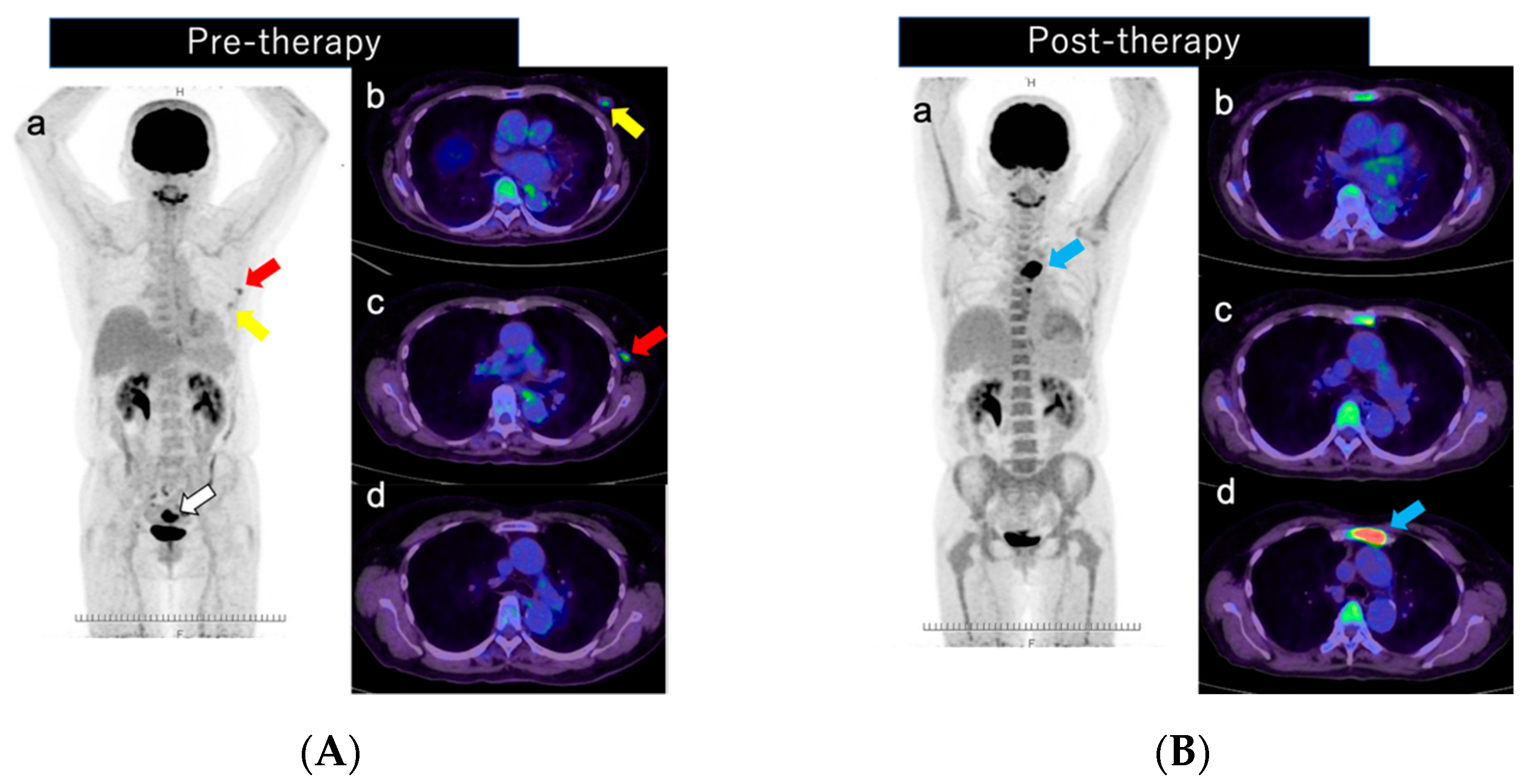Focal Uptake in the Sternum on 18F-FDG-PET/CT Caused by G-CSF Therapy after Chemotherapy Mimicking Bone Metastasis of Breast Cancer
Abstract
:1. Introduction
2. Case Presentation
3. Discussion
4. Conclusions
Author Contributions
Funding
Institutional Review Board Statement
Informed Consent Statement
Conflicts of Interest
References
- Mori, M.; Fujioka, T.; Katsuta, L.; Tsuchiya, J.; Kubota, K.; Kasahara, M.; Oda, G.; Nakagawa, T.; Onishi, I.; Tateishi, U. Diagnostic performance of time-of-flight PET/CT for evaluating nodal metastasis of the axilla in breast cancer. Nucl. Med. Commun. 2019, 40, 958–964. [Google Scholar] [CrossRef] [PubMed]
- Ishiba, T.; Nakagawa, T.; Sato, T.; Nagahara, M.; Oda, G.; Sugimoto, H.; Kasahara, M.; Hosoya, T.; Kubota, K.; Fujioka, T.; et al. Efficiency of fluorodeoxyglucose positron emission tomography/computed tomography to predict prognosis in breast cancer patients received neoadjuvant chemotherapy. SpringerPlus 2015, 4, 817. [Google Scholar] [CrossRef] [PubMed]
- Abouzied, M.M.; Crawford, E.S.; Nabi, H.A. 18F-FDG imaging: Pitfalls and artifacts. J. Nucl. Med. Technol. 2005, 33, 145–155. [Google Scholar] [PubMed]
- Kazama, T.; Swanston, N.; Podoloff, D.A.; Macapinlac, H.A. Effect of colony-stimulating factor and conventional- or high-dose chemotherapy on FDG uptake in bone marrow. Eur. J. Nucl. Med. Mol. Imaging 2005, 32, 1406–1411. [Google Scholar] [CrossRef] [PubMed]
- Mabuchi, S.; Morimoto, A.; Fujita, M.; Isohashi, K.; Kimura, T. G-CSF induces focal intense bone marrow FDG uptake mimicking multiple bone metastases from uterine cervical cancer: A case report and review of the literature. Eur. J. Gynaecol. Oncol. 2012, 33, 316–317. [Google Scholar] [PubMed]
- Nakamoto, Y.; Suga, T.; Hara, T.; Ishizu, K.; Togashi, K. Inhomogeneous Bone Marrow Uptake Caused by G-CSF Mimics Multiple Bone Metastases on FDG-PET. Clin. Nucl. Med. 2010, 35, 74–76. [Google Scholar] [CrossRef] [PubMed]
- Ruiz-Hernández, G.; Scaglione, C.; Delgado-Bolton, R.; Gutiérrez-García, A.; Madero, L.; Jiménez-Vicioso, A.; Carreras-Delgado, J. Hipercaptación esplénica secundaria a factor estimulador de colonias granulocitarias (G-CSF) en el estudio PET-FDG; Splenic and bone marrow increased 18F-FDG uptake in a PET scan performed following treatment with G-CSF. Rev. Esp. Med. Nucl. 2004, 23, 124–126. (In Spanish) [Google Scholar] [CrossRef]
- Boellaard, R.; O’Doherty, M.J.; Weber, W.A.; Mottaghy, F.M.; Lonsdale, M.N.; Stroobants, S.G.; Oyen, W.J.G.; Kotzerke, J.; Hoekstra, O.S.; Pruim, J.; et al. FDG PET and PET/CT: EANM procedure guidelines for tumour PET imaging: Version 1.0. Eur. J. Nucl. Med. Mol. Imaging 2010, 37, 181–200. [Google Scholar] [CrossRef] [PubMed] [Green Version]




Publisher’s Note: MDPI stays neutral with regard to jurisdictional claims in published maps and institutional affiliations. |
© 2022 by the authors. Licensee MDPI, Basel, Switzerland. This article is an open access article distributed under the terms and conditions of the Creative Commons Attribution (CC BY) license (https://creativecommons.org/licenses/by/4.0/).
Share and Cite
Hayashi, K.; Fujioka, T.; Hara, M.; Kumaki, Y.; Oda, G.; Yamaga, E.; Mori, M.; Ohnishi, I.; Kubota, K.; Nakagawa, T. Focal Uptake in the Sternum on 18F-FDG-PET/CT Caused by G-CSF Therapy after Chemotherapy Mimicking Bone Metastasis of Breast Cancer. Diagnostics 2022, 12, 2308. https://doi.org/10.3390/diagnostics12102308
Hayashi K, Fujioka T, Hara M, Kumaki Y, Oda G, Yamaga E, Mori M, Ohnishi I, Kubota K, Nakagawa T. Focal Uptake in the Sternum on 18F-FDG-PET/CT Caused by G-CSF Therapy after Chemotherapy Mimicking Bone Metastasis of Breast Cancer. Diagnostics. 2022; 12(10):2308. https://doi.org/10.3390/diagnostics12102308
Chicago/Turabian StyleHayashi, Kumiko, Tomoyuki Fujioka, Masatake Hara, Yuichi Kumaki, Goshi Oda, Emi Yamaga, Mio Mori, Iichiroh Ohnishi, Kazunori Kubota, and Tsuyoshi Nakagawa. 2022. "Focal Uptake in the Sternum on 18F-FDG-PET/CT Caused by G-CSF Therapy after Chemotherapy Mimicking Bone Metastasis of Breast Cancer" Diagnostics 12, no. 10: 2308. https://doi.org/10.3390/diagnostics12102308




